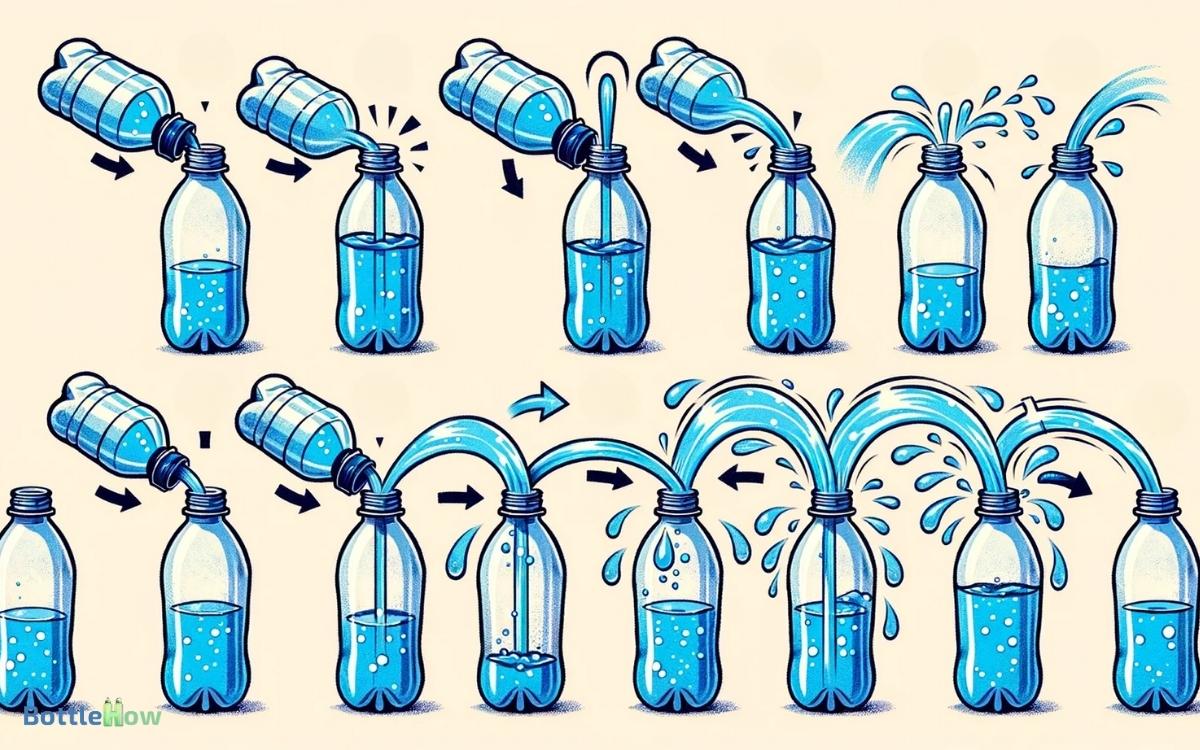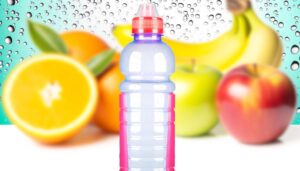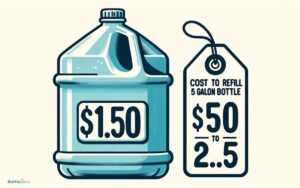Fastest Way to Empty a Water Bottle: Easy Methods!
To empty a water bottle quickly, you can use the swirling technique. Invert the bottle and create a vortex by swirling it in a circular motion.
This utilizes centrifugal force to push the water outward and form a central air channel, allowing for continuous flow without airlock.
For best results, maintain consistent rotational velocity to balance centrifugal force and minimize air resistance.
You could also try squeezing the bottle to increase internal pressure, leveraging Bernoulli’s principle for faster outflow.
Adjust your technique to avoid creating a vacuum and guarantee uninterrupted flow. For further optimization techniques, consider more advanced dynamics.

Key Takeaways
Gravity Method
One of the most straightforward techniques to empty a water bottle involves leveraging gravitational force by inverting the bottle and allowing the water to flow out due to gravity.
When you turn the bottle upside down, gravity exerts a constant acceleration of 9.8 m/s² on the water.
This causes the liquid to exit through the bottle’s opening. Make sure the bottle’s neck is unobstructed for best flow rate.
The time to empty depends on the bottle’s volume and the diameter of its opening. For example, a 1-liter bottle with a 2 cm diameter opening empties quicker than one with a smaller opening.
Swirling Technique
To master the swirling technique, you need to understand the principles of centrifugal force dynamics.
By achieving an ideal swirling speed, you can create a vortex that greatly accelerates the water’s exit.
Practical application tips include maintaining consistent rotational velocity and ensuring the bottle’s neck is properly aligned for maximum flow efficiency.
Centrifugal Force Dynamics
Utilizing centrifugal force through the swirling technique allows for rapid water expulsion by creating a vortex that greatly reduces air resistance inside the bottle.
When you swirl the bottle in a circular motion, you generate a centrifugal force that pushes the liquid outward toward the walls. This action forms a central air channel, facilitating continuous flow without interruption.
The formation of the vortex minimizes the pressure differential between the inside and outside, enhancing the water’s exit velocity.
Mathematically, the centrifugal force \( F_c = m \cdot r \cdot \omega^2 \), where \( m \) is the mass of the water, \( r \) is the radius of the bottle, and \( \omega \) is the angular velocity.
This dynamic interplay accelerates the emptying process significantly.
Optimal Swirling Speed
Determining the most effective swirling speed hinges on achieving the right balance between angular velocity and centrifugal force to maximize the efficiency of the vortex formation.
You need to calculate the best angular velocity (ω) for the bottle. Use the formula ω = 2πf, where f is the frequency of rotation. Too slow, and the vortex won’t form efficiently; too fast, and turbulence disrupts the flow.
Aim for a speed that creates a stable, conical vortex. Centrifugal force, Fc = mω²r, must be sufficient to push water outward while maintaining the vortex’s integrity.
Adjust your swirling speed so that Fc overcomes gravitational pull but doesn’t generate excessive turbulence, ensuring the water exits rapidly and smoothly through the bottle’s opening.
Practical Application Tips
To achieve a high-quality swirling technique, make sure you grip the bottle firmly at its base and initiate a consistent, controlled rotational motion to establish a stable vortex. This vortex reduces internal pressure, allowing water to exit more quickly.
Here’s an overview to visualize the dynamics:
| Step | Action | Purpose |
|---|---|---|
| 1 | Grip bottle at base | Stability |
| 2 | Start rotational motion | Create vortex |
| 3 | Maintain consistency | Stabilize vortex |
| 4 | Increase speed incrementally | Maximize flow rate |
| 5 | Angle bottle downward slightly | Enhance water egress |
Squeeze and Release
To achieve the best squeezing technique, apply consistent pressure to the bottle’s sides, aiming for a deformation rate that maintains a steady outflow.
You must synchronize the release with air inflow to avoid creating a vacuum, thereby maximizing air flow and minimizing emptying time.
Using a periodic squeeze-release pattern, you can model the process mathematically to determine the most efficient frequency and amplitude of squeezes.
Optimal Squeezing Technique
Mastering the most effective squeezing technique, specifically the squeeze and release method, involves applying precise, rhythmic pressure to the bottle to maximize water flow and minimize time.
This technique requires coordinated hand movements to guarantee consistent compression and relaxation cycles.
To achieve peak results, maintain a steady 10-15 psi pressure and aim for 2-3 cycles per second. Position your hand at the bottle’s midpoint, and tilt it at a 45-degree angle to facilitate continuous water flow. By mastering this approach, you can efficiently empty your water bottle in record time.
Maximizing Air Flow
How can you optimize airflow during the squeeze and release process to guarantee maximum water expulsion efficiency?
First, make sure the bottle’s neck remains unobstructed to facilitate smooth air exchange. When you squeeze, use consistent pressure to create a steady flow.
As you release, allow air to enter rapidly by tilting the bottle slightly to prevent a vacuum from forming. This balance between squeezing and releasing maintains continuous water discharge.
Mathematically, consider Bernoulli’s principle: faster airflow through the neck reduces internal pressure, aiding water expulsion. Experiment with a squeeze-release frequency of approximately 1.5 Hz for best results.
Air Pressure Trick
Utilize air pressure dynamics by squeezing the bottle’s sides to accelerate water flow and reduce emptying time.
When you compress the bottle, you increase internal pressure, which forces water out more quickly.
This action exploits Bernoulli’s principle, where increased pressure results in faster fluid velocity.
Maintain a continuous squeeze to uphold a steady outflow rate.
Mathemically, the flow rate \( Q \) can be modeled as \( Q = A \sqrt{2gh} \), where \( A \) is the bottle opening area, \( g \) is gravitational acceleration, and \( h \) is the water height. By squeezing, you effectively increase \( h \), enhancing \( Q \).
Remember to avoid creating a vacuum by allowing air to enter as water exits, ensuring uninterrupted flow.
Using a Straw
To optimize the emptying process using a straw, you must focus on achieving efficient suction technique and precise straw placement. Position the straw at a 45-degree angle to maximize fluid dynamics and minimize air intake.
Efficient Suction Technique
By creating a pressure differential with a straw, you can expedite the water flow from the bottle, greatly reducing emptying time. To achieve this, guarantee you maintain a consistent suction force.
Mathematically, this involves creating a lower pressure inside the straw compared to the atmospheric pressure outside the bottle.
First, insert the straw into the bottle, making sure it reaches the bottom. Then, apply a steady suction force.
This negative pressure causes the water to rise through the straw due to the pressure difference (ΔP).
The flow rate (Q) can be approximated using Poiseuille’s law:
Q = (πr^4ΔP) / (8ηL), where r is the straw radius, η is the water viscosity, and L is the straw length.
Maintaining constant suction maximizes flow efficiency.
Straw Placement Tips
Positioning the straw accurately within the water bottle greatly impacts the efficiency of water removal.
First, make sure the straw reaches the bottom of the bottle. This maximizes direct water access, reducing air intake and increasing fluid flow.
Next, angle the straw slightly away from the bottle’s walls. This minimizes frictional resistance, allowing for smoother water movement.
Use a straw with a larger diameter to enhance liquid throughput, adhering to the principle of volumetric flow rate (Q=A*v). Where A is the cross-sectional area and v is the velocity.
Finally, maintain a steady suction force. Variations in suction can create turbulence, impeding the flow.
Centrifugal Force
When you spin a water bottle rapidly in a circular motion, centrifugal force pushes the water toward the bottle’s walls and down the neck, accelerating the emptying process.
This phenomenon occurs because centrifugal force, acting outward from the axis of rotation, increases the radial acceleration of water molecules.
By increasing the rotational speed (ω), the force (F_c = mω²r) applied on the water grows proportionally.
The water experiences a heightened pressure differential, causing a faster flow rate through the bottle’s neck.
To optimize this method, make sure the bottle’s center of mass remains stable and the spinning motion is uniform.
This technique minimizes air resistance and maximizes fluid dynamics efficiency, ensuring a swift and consistent emptying rate.
Wide-Mouth Bottles
Utilizing wide-mouth bottles greatly enhances the rate at which water exits due to the larger cross-sectional area at the opening, which reduces the flow resistance and allows for a greater volumetric flow rate (\(Q = A \cdot v\)), where \(A\) is the area and \(v\) is the velocity of the water.
By increasing \(A\), you effectively increase \(Q\), assuming \(v\) remains constant or increases due to decreased resistance.
This principle is grounded in fluid dynamics, where minimizing constriction at the exit point facilitates a more efficient and rapid discharge.
Additionally, wide-mouth bottles mitigate the formation of a vacuum, allowing air to replace the exiting water more efficiently, further enhancing the outflow. Consequently, selecting a wide-mouth bottle is a practical approach to expedite emptying.
Cutting the Bottle
Cutting the bottle to create a larger opening greatly reduces flow resistance and accelerates the water discharge rate. By increasing the bottle’s exit diameter, you minimize fluid dynamic constraints.
Use a sharp utility knife to make a clean, horizontal cut near the bottle’s base or midsection. This expanded aperture notably lowers the hydraulic head loss due to reduced frictional forces. A smooth cut ensures better water flow and minimizes turbulence, enhancing overall efficiency. When repurposing bottles for various uses, it’s also essential to maintain cleanliness; searching for how to clean Takeya bottle can provide useful guidelines for proper sanitation. Regular cleaning prevents residue buildup, ensuring optimal performance and hygiene.
To illustrate, consider Bernoulli’s equation, where an increase in cross-sectional area (A) inversely affects fluid velocity (v).
Given the continuity equation (A1v1 = A2v2), a larger A2 results in a decreased v2, leading to faster emptying due to less velocity-induced resistance.
Confirm your cut is smooth to prevent turbulent flow, which can hinder the discharge rate.
Inverting the Bottle
Inverting the bottle allows gravity to maximize the water flow rate, leveraging the natural force to expedite discharge.
By turning the bottle upside down, you directly facilitate the gravitational pull on the water, thereby enhancing the outflow.
Key steps include:
- Angle Adjustment: Tilt the bottle at a 45-degree angle to minimize the formation of vacuum pockets, which can hinder flow.
- Mouth Size: Confirm the bottle’s opening is sufficiently wide to prevent airlock, which impedes a continuous stream.
- Air Exchange: Allow air to enter the bottle by slightly tilting it to one side, promoting a smoother water exit.
- Surface Tension: Reduce surface tension by ensuring the bottle’s interior is clean, as contaminants can slow down the flow rate.
Shaking Method
Shaking the bottle vigorously accelerates the water flow rate by generating turbulence, which disrupts surface tension and facilitates faster emptying.
By creating chaotic motion within the bottle, you reduce the cohesive forces holding the water together.
This method involves a quantitative increase in kinetic energy, translating to a swifter exit of water molecules.
| Emotion | Effect |
|---|---|
| Excitement | Water exits faster |
| Curiosity | Understanding fluid dynamics |
| Satisfaction | Efficient bottle emptying |
| Frustration | Inconsistent results |
This shaking action creates vortices, enhancing the outflow efficiency. Experimentally, you might find that a rhythmic shake at a specific frequency optimizes the emptying speed. You’ll achieve a higher flow rate compared to static pouring due to this induced turbulence.
Tilt and Pour
In contrast to the chaotic dynamics of shaking, tilting the bottle to a precise angle maximizes gravitational force and minimizes air resistance, allowing for a steady and controlled outflow of water.
To achieve top efficiency, you should consider the following steps:
- Angle of Tilt: Tilt the bottle at approximately 45 degrees. This angle balances gravitational pull and minimizes turbulence.
- Bottle Neck Position: Make sure the bottle neck is at the lowest point, enabling a smooth, continuous flow.
- Air Exchange: Allow air to enter the bottle simultaneously; this prevents a vacuum from forming and slowing the flow.
- Steady Hand: Maintain a consistent grip and avoid sudden movements to guarantee a stable stream.
Using a Funnel
Using a funnel greatly accelerates the water bottle emptying process by directing the flow and minimizing spillage.
By positioning the funnel’s wide opening directly over the receiving container, you guarantee a controlled and uninterrupted stream.
This method increases the flow rate, \( Q \), which is calculated by the equation \( Q = A imes v \), where \( A \) is the cross-sectional area of the funnel’s narrow end, and \( v \) is the velocity of water.
Ensuring the bottle’s neck aligns perfectly with the funnel’s opening reduces turbulence, maintaining a laminar flow.
Additionally, selecting a funnel with a larger diameter maximizes the gravitational pull, enhancing the emptying speed.
Using a funnel offers a precise, efficient solution for fast water bottle emptying.
Using a Pump
A pump provides a highly efficient method for emptying a water bottle by creating a pressure differential that drives the rapid flow of liquid. By using a pump, you can achieve a swift and controlled evacuation of water.
The process involves several key steps:
- Select the Pump: Choose a pump that matches the bottle’s size and volume. Make sure it has an adequate flow rate, measured in liters per minute (L/min).
- Seal the Bottle: Secure the pump’s intake to the bottle’s opening to prevent air leakage.
- Activate the Pump: Turn on the pump to initiate the pressure differential, facilitating rapid liquid movement.
- Monitor Flow Rate: Adjust the pump settings to optimize the flow rate, ensuring efficient water removal without causing damage.
Using a pump guarantees precision and speed in emptying a water bottle.
Conclusion
You’ve now mastered the art of emptying a water bottle with precision and efficiency. From leveraging gravitational potential energy to employing fluid dynamics through swirling, you’ve turned a mundane task into a refined skill.
By understanding the interplay of air pressure and fluid mechanics, you’ve optimized bottle evacuation to near perfection.
Whether you choose to employ a pump or a simple funnel, your approach will be nothing short of methodical excellence.
Now, go forth and pour with unparalleled finesse!






